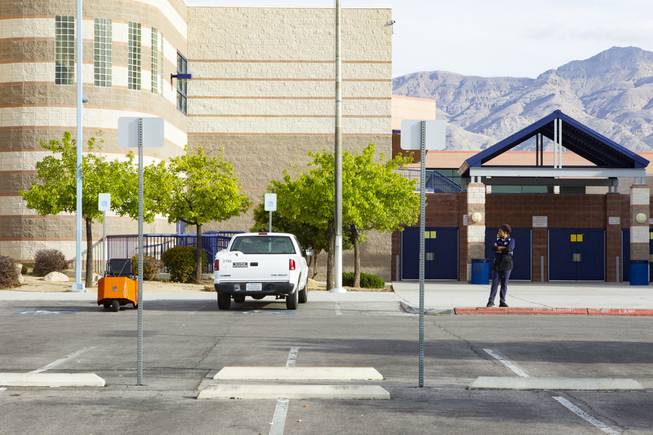
A Clark County School District employee waits to hand out meals during distribution hours at Shadow Ridge High School Monday, March, 16, 2020.
Thursday, May 7, 2020 | 2 a.m.
On March 26, Superintendent Jésus Jara sent a message to parents and employees touting the Clark County School District’s distance education plan to be used while schools are closed. “In just two days since the formal distance education plan was deployed, teachers have made 185,365 contacts with students across the district,” he said.
Education
- Shaking the System: Could the coronavirus alter American education beyond the near future?
- Students across the Vegas Valley weigh in on the class time they’ve missed
- Can online learning truly be equal for all?
- Advice from homeschooling parents, plus home-tested resources
- Home learning resources, from reading to cooking to crafts
- Advice for those of us suddenly helping to teach family members
- Superintendent discusses the well-being of students and families, and schools’ options moving forward
- How is the Clark County School District handling the closure of its campuses?
- UNLV, CSN developing plans for students to return in fall
More than a month later, the numbers are only marginally better. The week of April 13, 211,438 students were contacted by teachers, according to a report submitted to the Nevada Department of Education. That leaves out approximately 110,000 CCSD students.
The same week, 11,451 students were granted a “documented exemption” because they didn’t have access to a computer, Chromebook or Wi-Fi, or were unable to travel to a designated pickup site to pick up a work packet. That’s despite the district’s commitment to distribute a Chromebook from its stash of 225,927 to every student who needs one.
Even for those who have the tools to complete schoolwork and are in touch with teachers, it remains unclear how much they’re learning. Teachers are required to contact students a minimum of once per week. They’ve been instructed to focus on review, and none of the work is mandatory or graded.
“For parents and students, that becomes confusing,” says Rebecca Garcia, president of the Nevada PTA and a member of the superintendent’s parent advisory council. “For a lot of students, and quite frankly parents, they hear ‘not required’ and say, ‘Who cares?’”
Days after Gov. Steve Sisolak mandated that schools close, Jara said he couldn’t “guarantee” all students would be educated during the pandemic because of inequities within the district. Now that schools will stay closed through the end of the school year—and possibly beyond—what’s the plan for addressing the education gaps that will have inevitably deepened once this is all over?
So far, the district has pledged to offer enhanced summer school programming. The details of that programming, including whether it will be offered at no cost and whether new material will be taught, will be released soon. “Right now, we’re finalizing the final touches to that. It’s something we have to invest in,” Jara said.
District officials have also begun making in-person contact with students whom teachers and principals have not been able to reach. In addition, CCSD is banking on federal money—$75 million from the federal coronavirus relief package, the CARES Act, and possibly more from future stimulus bills—to bring students up to speed in the coming months, even as pandemic-fueled budget cuts loom.
Meanwhile, the Nevada Department of Education recently announced the creation of the Reopening of Schools Committee, to help school districts and charter schools create and implement “a framework for a safe, efficient and equitable return to school.” Consisting of health officials, superintendents, charter school leaders and other experts, the committee will in part assist districts in identifying local priorities and becoming better prepared for future emergencies. It will not address academic needs during or after the closures.
“Nevada has a long-standing tradition of local control and, as such, district and school leaders make decisions regarding the specific content of distance education, curriculum, grades, etc.,” the department affirmed.
This story appeared in Las Vegas Weekly.
